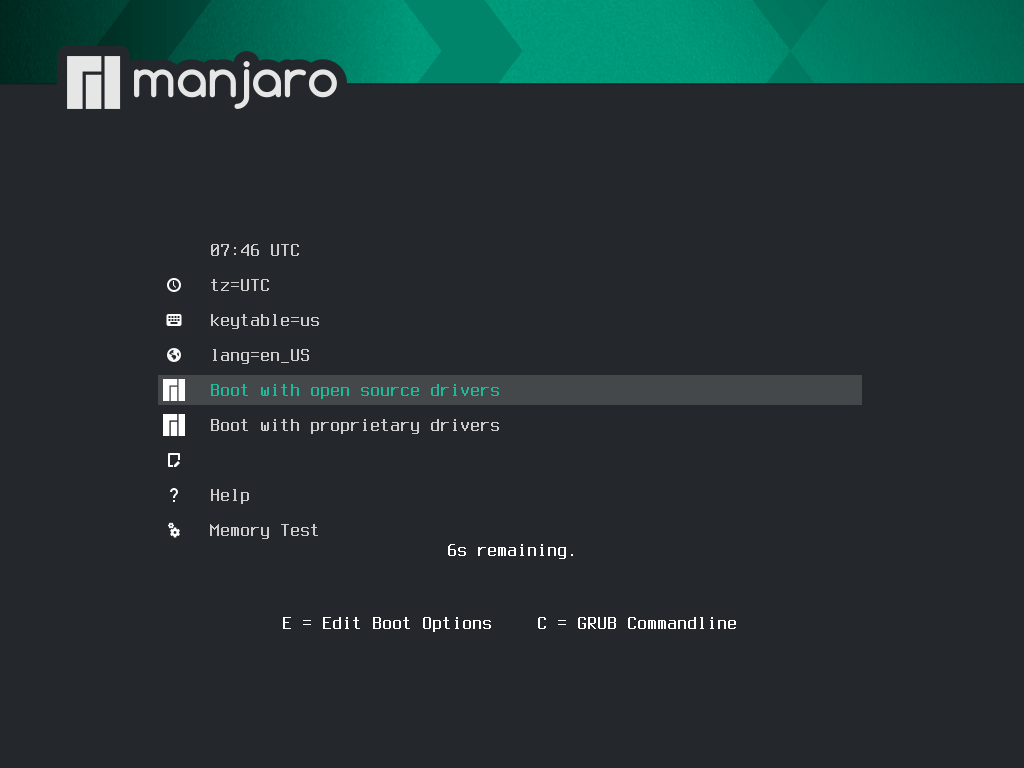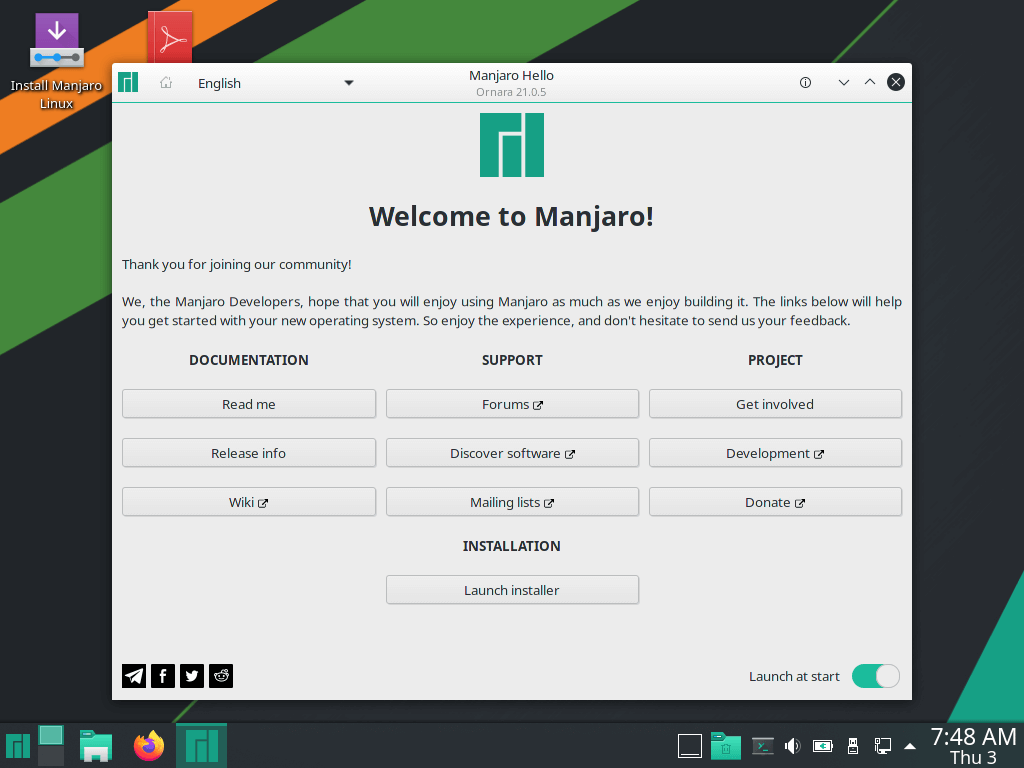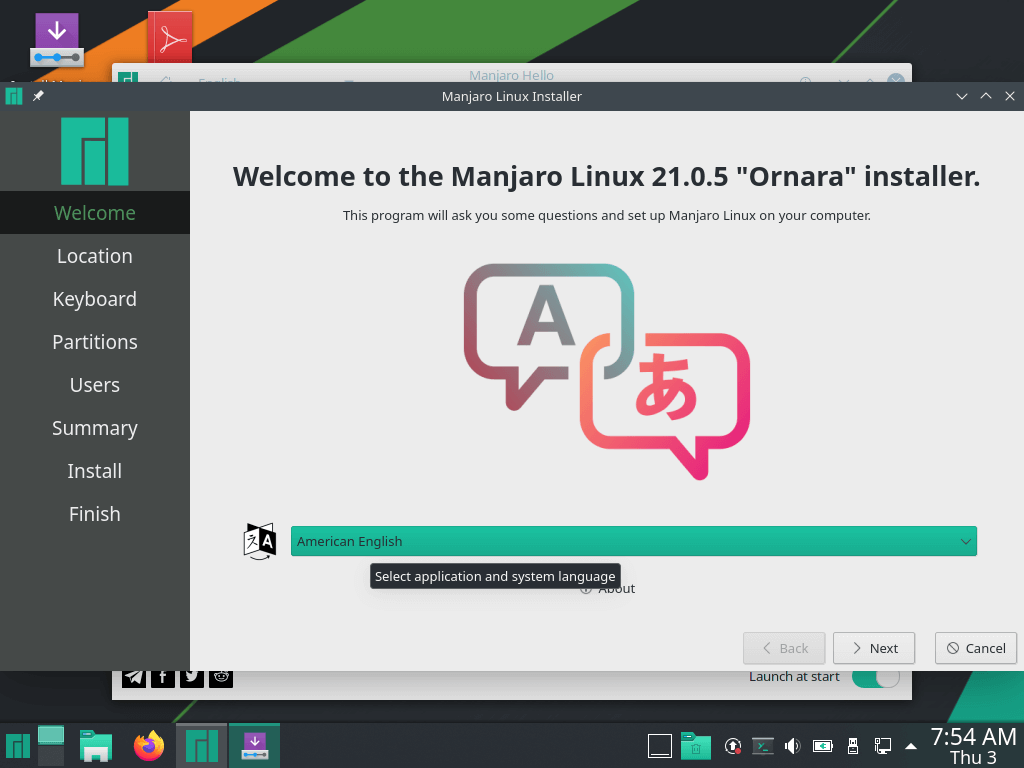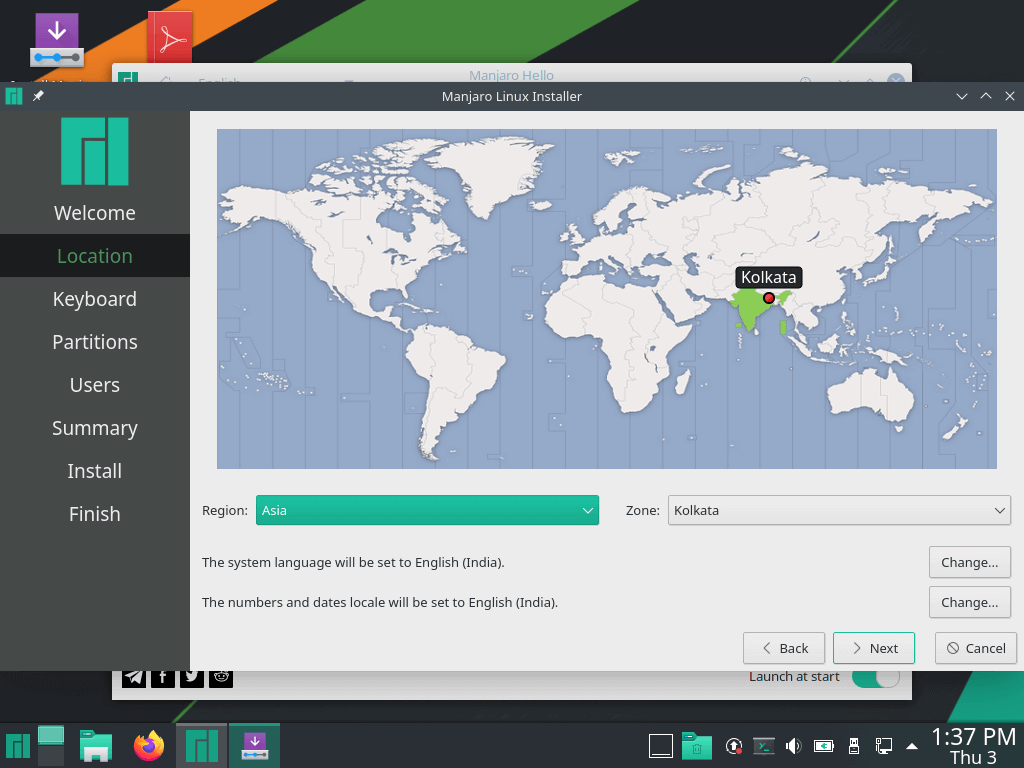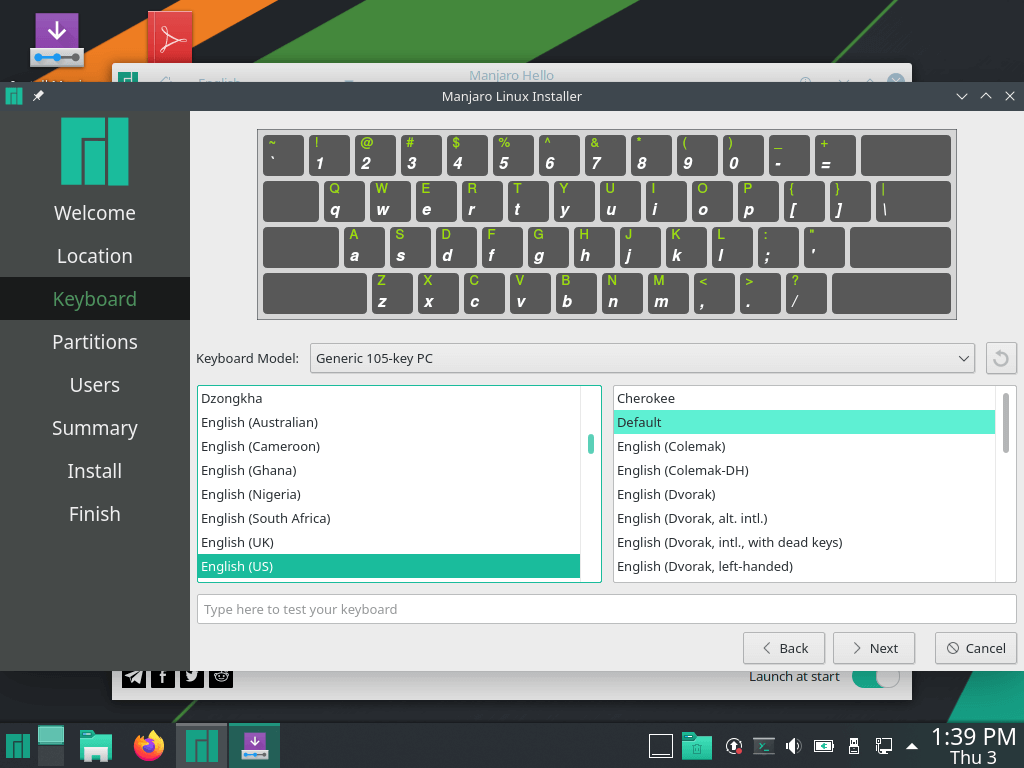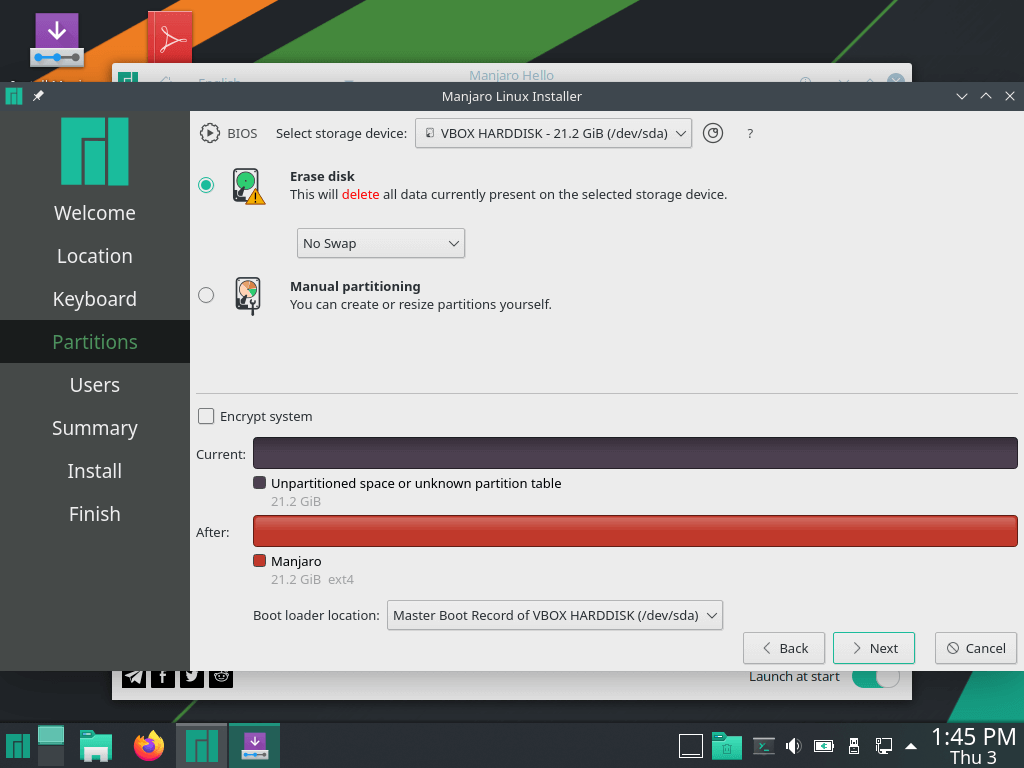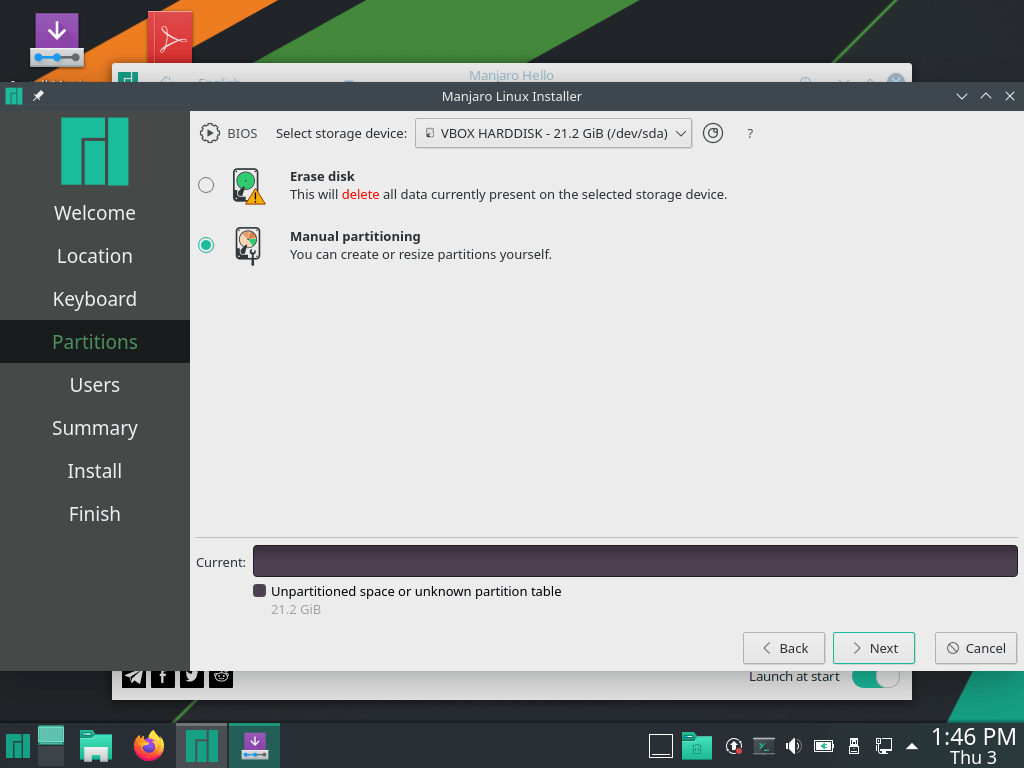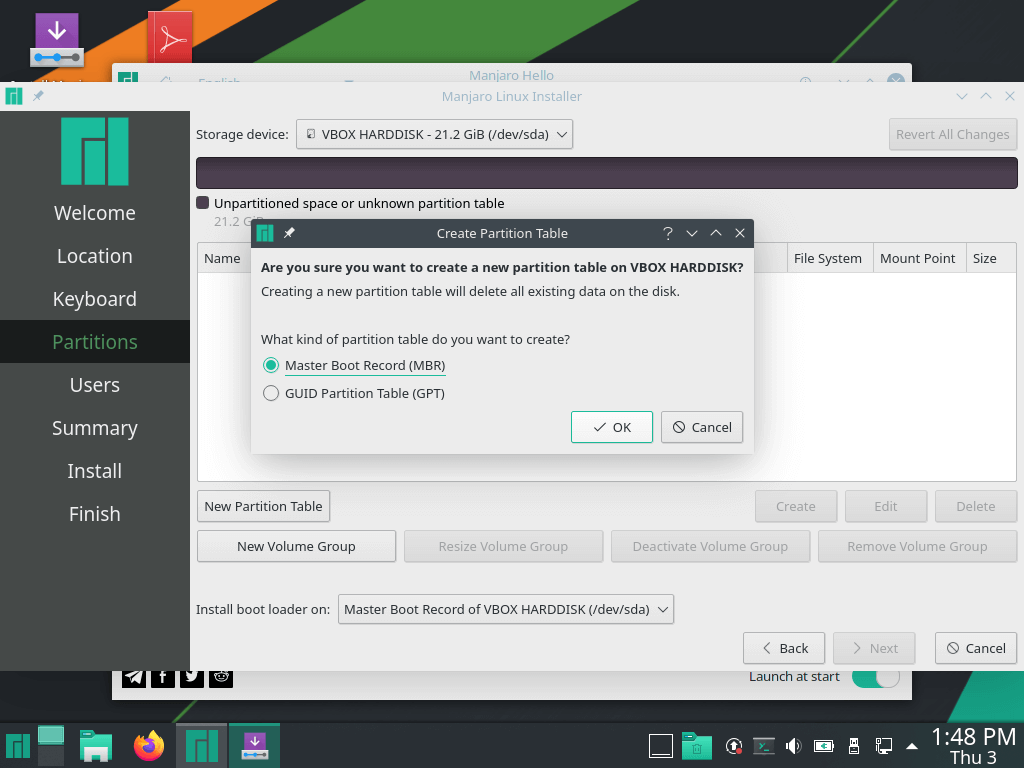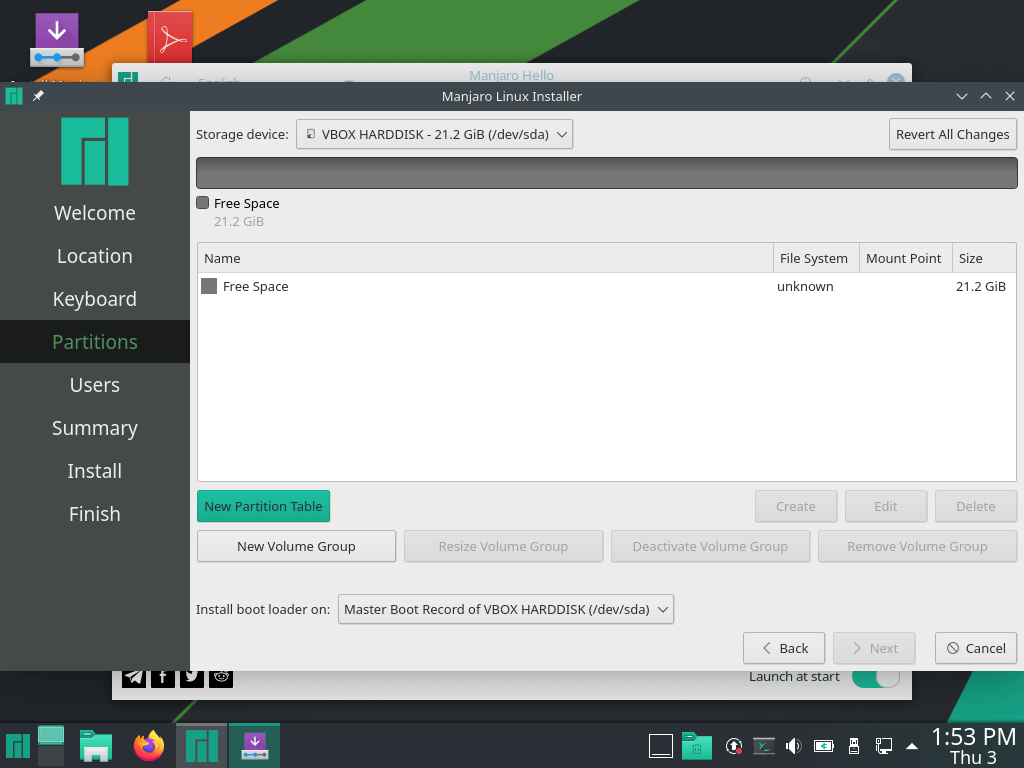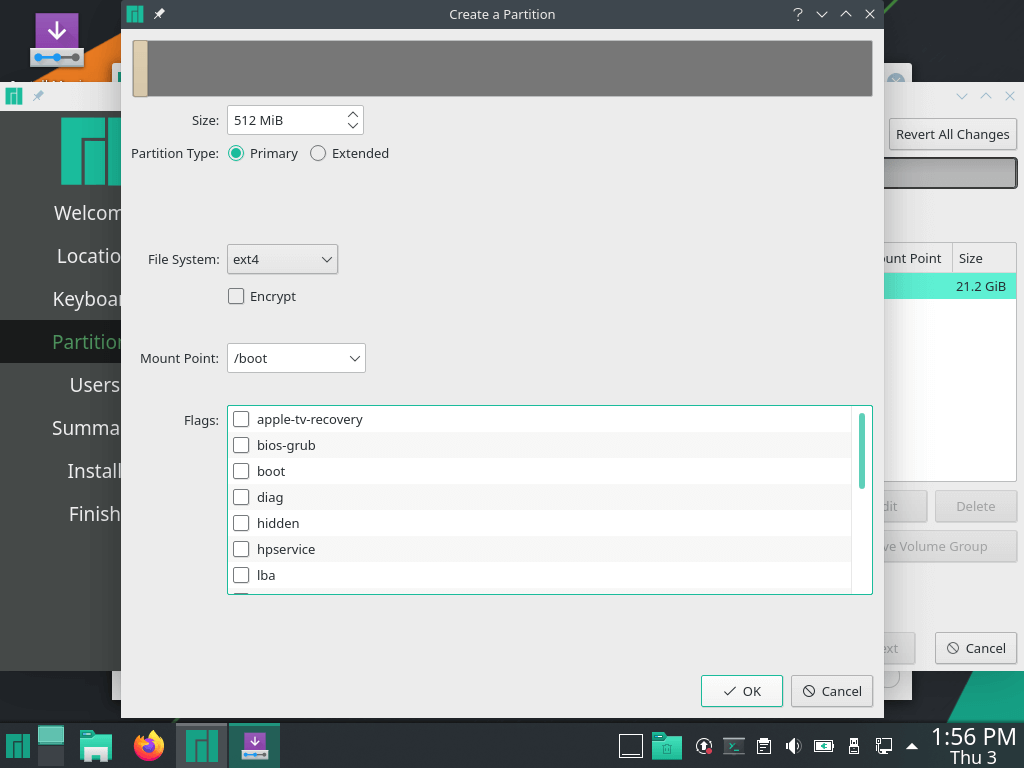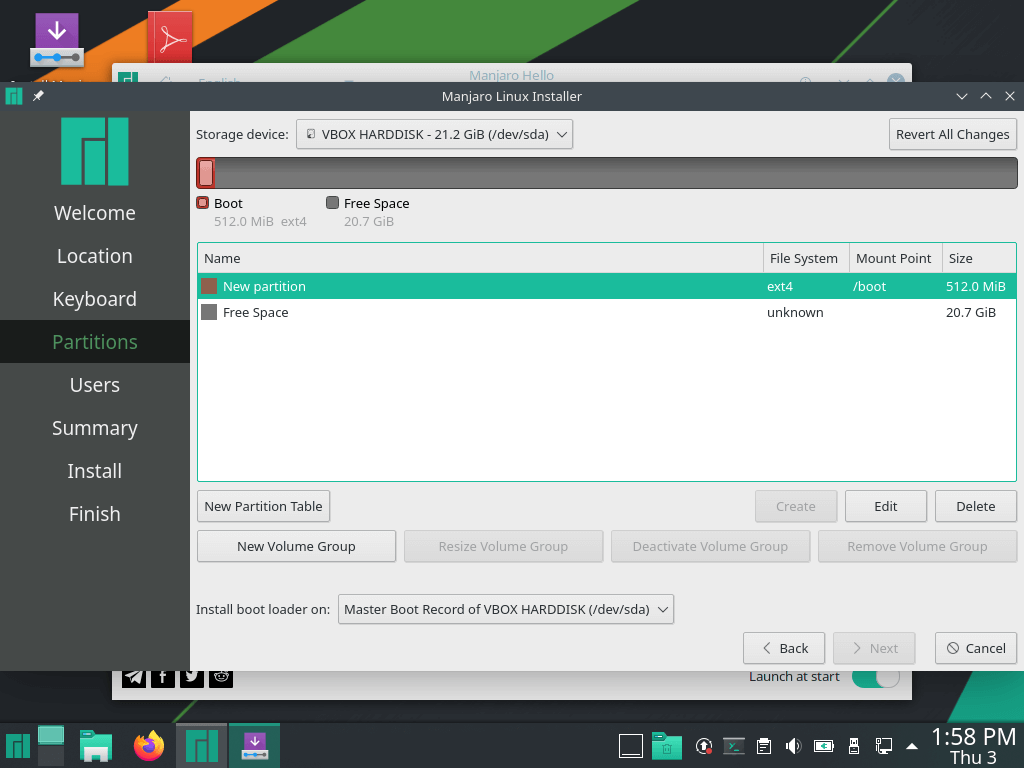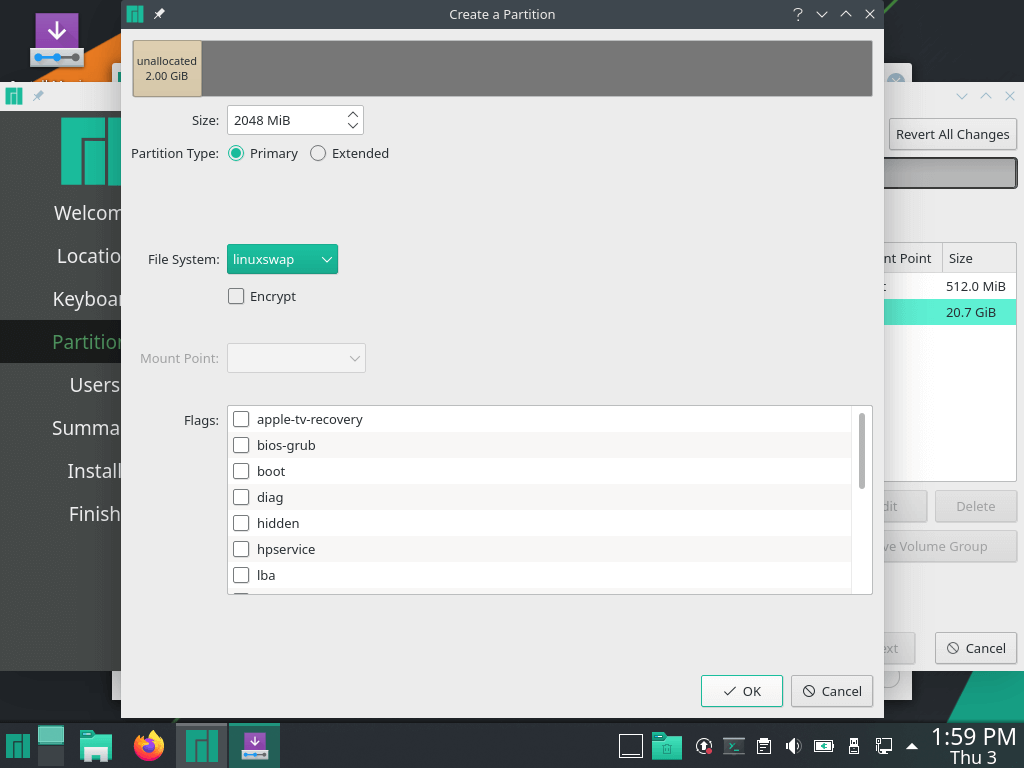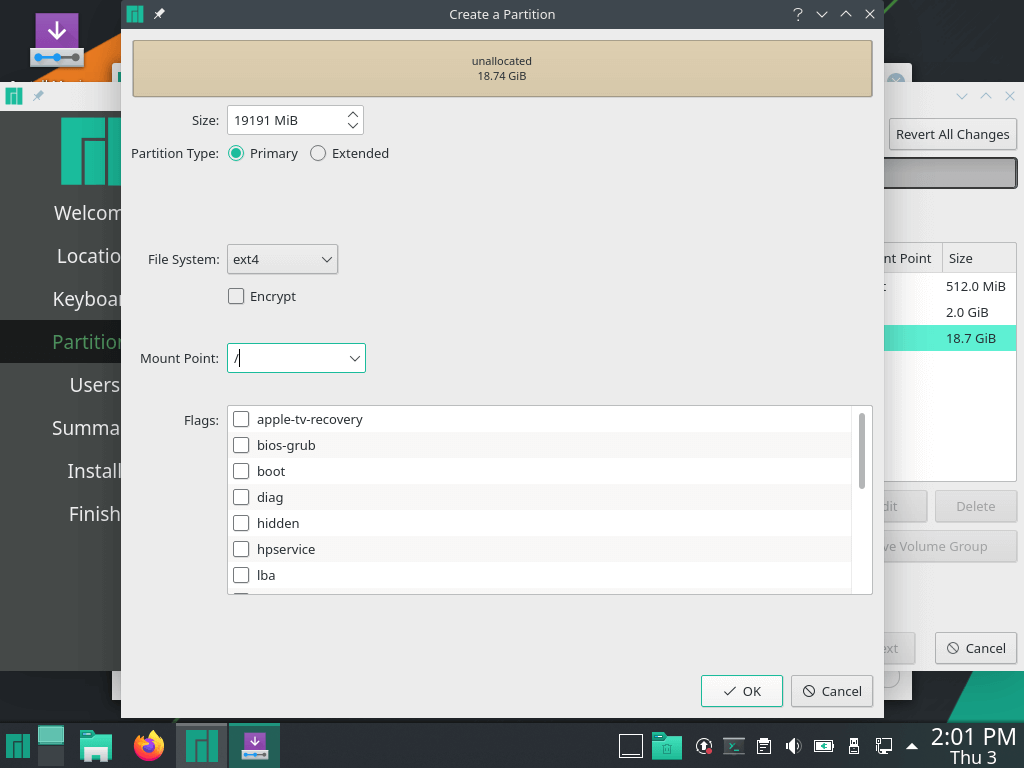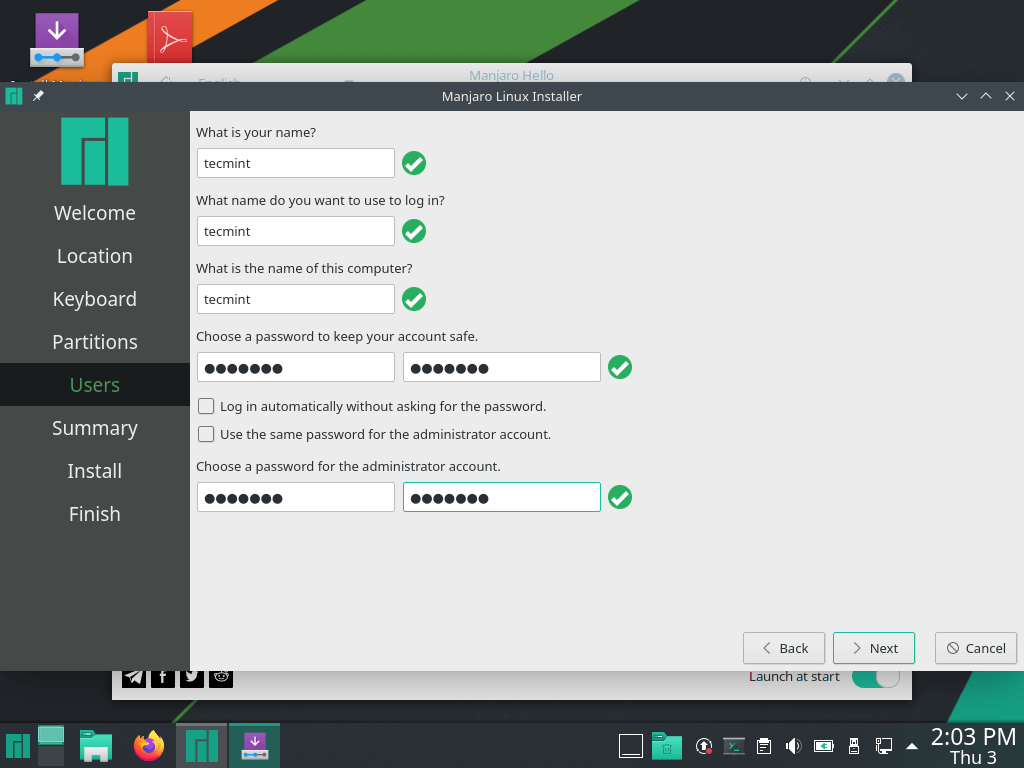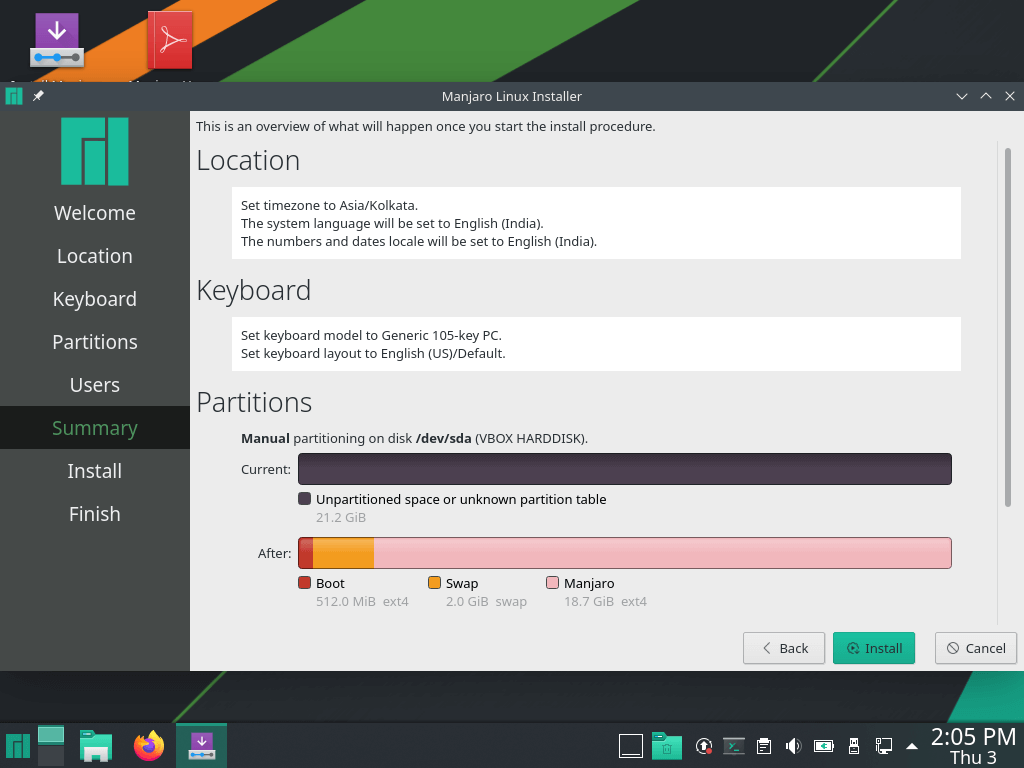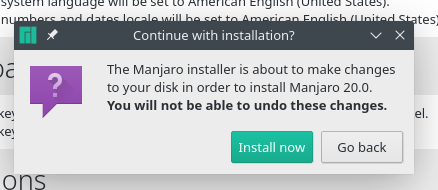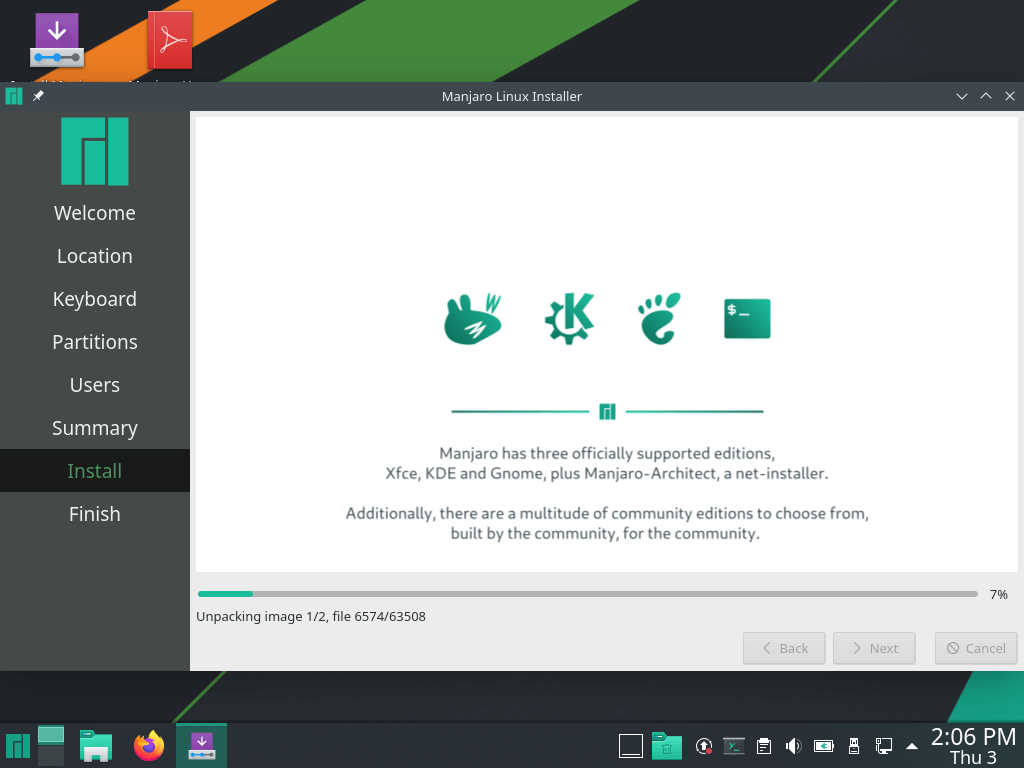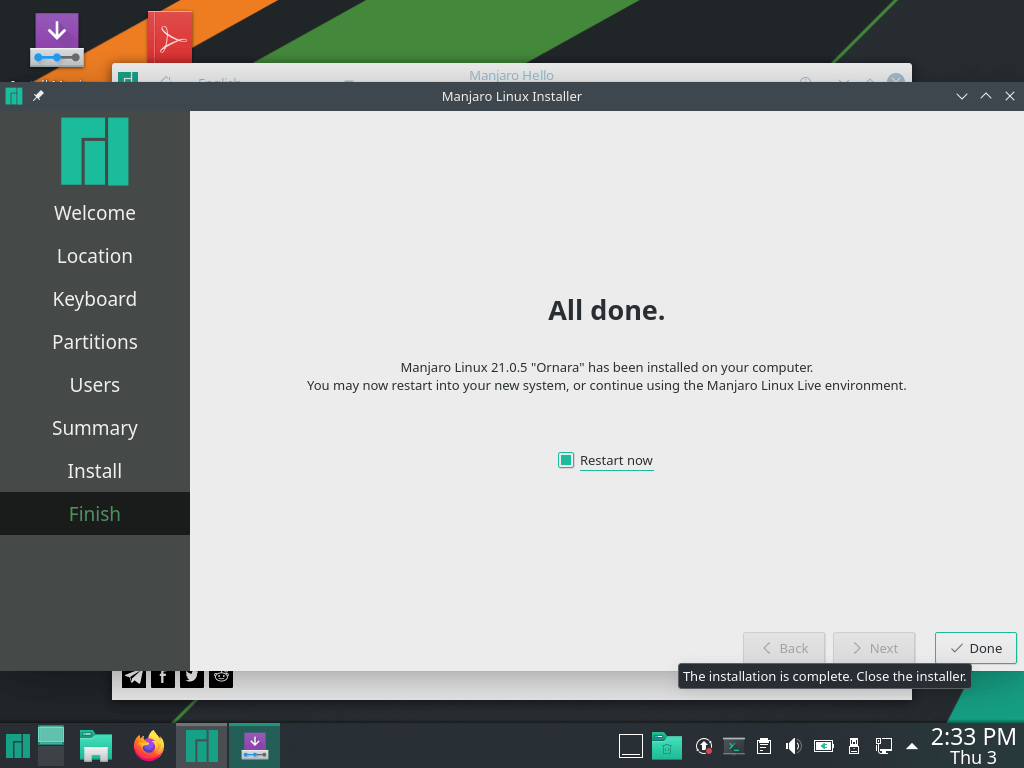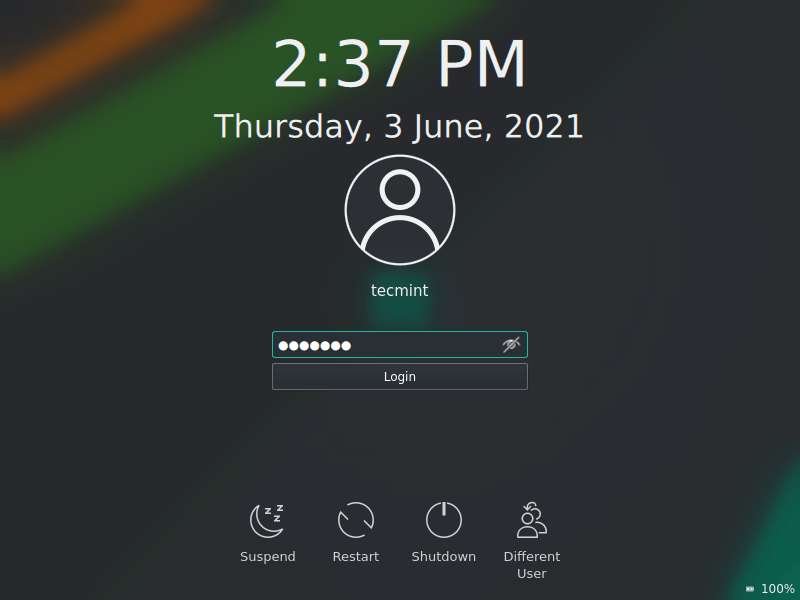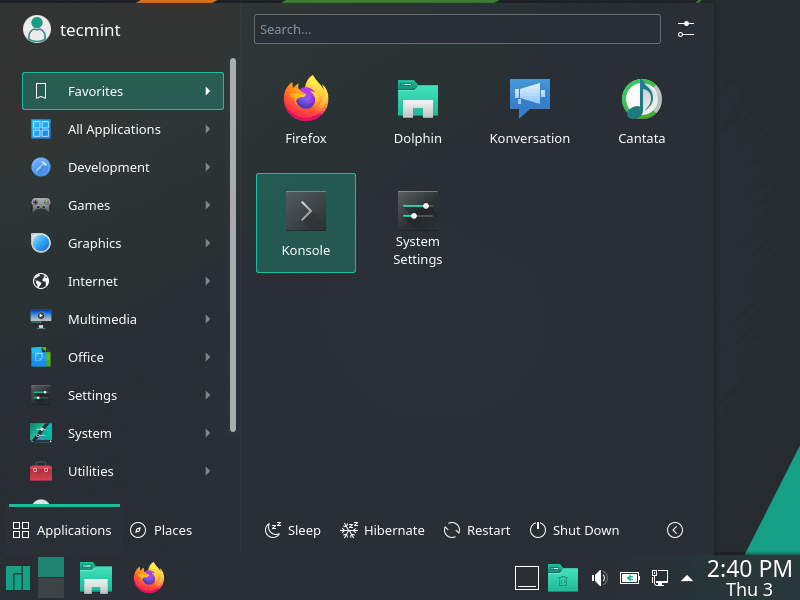- About Manjaro
- About Manjaro
- Installation of Manjaro 21.0 (KDE Edition) Desktop
- Manjaro System Requirements
- Download Manjaro ISO Images
- Installing Manjaro 21.0 (KDE Edition) Desktop
- Booting Manjaro Linux
- Select System Language
- Select the Timezone
- Select Keyboard Layout
- Partition Hard Disk
- Create a User Account
- Manjaro Installation Summary
- Begin Manjaro Installation
About Manjaro
Manjaro Linux targets beginners and advanced users at the same time. We provide user interface tools and scripts to make life easier. Manjaro supports NVIDIA’s Optimus technology out of the box. – Philip Müller — Manjaro Developer
Manjaro is a user-friendly Linux distribution based on the independently developed Arch operating system. Within the Linux community, Arch itself is renowned for being an exceptionally fast, powerful, and lightweight distribution that provides access to the very latest cutting edge — and bleeding edge — software. However, Arch is also aimed at more experienced or technically-minded users. As such, it is generally considered to be beyond the reach of those who lack the technical expertise (or persistence) required to use it.
Developed in Austria, France, and Germany, Manjaro provides all the benefits of the Arch operating system combined with a focus on user-friendliness and accessibility. Manjaro follow Archlinux and officially only offers a 64 bit version. Manjaro is suitable for newcomers as well as experienced Linux users. For newcomers, a user-friendly installer is provided, and the system itself is designed to work fully ‘straight out of the box’ with features including:
- Pre-installed desktop environments
- Pre-installed Graphical Software Managers to easily install software and update your system, and
- Pre-installed codecs to play multimedia files
For more experienced — and adventurous — users Manjaro also offers the configurability and versatility to be shaped and moulded in every respect to suit personal taste and preference. Manjaro Architect is both a CLI installer, available side by side with the graphics installer and a CLI based ISO giving the option to install any Manjaro flavours and offers unflavoured DE installation, filesystem choices and bootloader choice for those who want complete freedom to shape their system; starting from a command line, you are completely free to chose your own greeters, desktops, hardware drivers, software applications, and so on!
Manjaro shares many of the same features as Arch, including:
- Speed, power, and efficiency
- Access to the very latest cutting and bleeding edge software
- A ‘rolling release’ development model that provides the most up-to-date system possible without the need to install new versions, and
- Access to the Arch User Repository (AUR).
However, Manjaro boasts a few extra features of its own, including:
- A simplifed, user-friendly installation process
- Automatic detection of your computer’s hardware (e.g. graphics cards)
- Automatic installation of the necessary software (e.g. graphics drivers) for your system
- Its own dedicated software repositories to ensure delivery of fully tested and stable software packages, and
- Support for the easy installation and use of multiple kernels.
The latest stable and community releases are available from Manjaro
Official announcements can be viewed at Manjaro News.
Info Community Editions differ from official releases insofar as they are not subject to the same release schedules, and will only be developed when the time and resources are available.
The latest test-builds of Manjaro are available from OSDN
About Manjaro
Manjaro Linux targets beginners and advanced users at the same time. We provide user interface tools and scripts to make life easier. Manjaro supports NVIDIA’s Optimus technology out of the box. – Philip Müller — Manjaro Developer
Manjaro is a user-friendly Linux distribution based on the independently developed Arch operating system. Within the Linux community, Arch itself is renowned for being an exceptionally fast, powerful, and lightweight distribution that provides access to the very latest cutting-edge and bleeding-edge software. However, Arch is also aimed at more experienced or technically-minded users. As such, it is generally considered to be beyond the reach of those who lack the technical expertise (or persistence) required to use it.
Developed in Austria, France, and Germany, Manjaro provides all the benefits of the Arch operating system combined with a focus on user-friendliness and accessibility. Manjaro follows Arch Linux and officially only offers a 64-bit version. Manjaro is suitable for both newcomers as well as experienced Linux users. For newcomers, a user-friendly installer is provided, and the system itself is designed to work fully ‘straight out of the box’ with features including:
- Pre-installed desktop environments
- Pre-installed Graphical Software Managers to easily install software and update your system
- Pre-installed codecs to play multimedia files
For more experienced — and adventurous — users Manjaro also offers the configurability and versatility to be shaped and moulded in every respect to suit personal taste and preference. Manjaro Architect is both a CLI installer, available side by side with the graphics installer, and a CLI-based ISO giving the option to install any Manjaro flavour, and offers unflavoured DE installation, filesystem choices, and bootloader choice for those who want complete freedom to shape their system. Starting from the command line, you are completely free to chose your own greeters, desktops, hardware drivers, software applications, and so on!
Manjaro shares many of the same features as Arch, including:
- Speed, power, and efficiency
- Access to the very latest cutting and bleeding edge software
- A ‘rolling release’ development model that provides the most up-to-date system possible without the need to install new versions, and
- Access to the Arch User Repository (AUR).
However, Manjaro boasts a few extra features of its own, including:
- A simplifed, user-friendly installation process
- Automatic detection of your computer’s hardware (e.g. graphics cards)
- Automatic installation of the necessary software (e.g. graphics drivers) for your system
- Its own dedicated software repositories to ensure delivery of fully tested and stable software packages, and
- Support for the easy installation and use of multiple kernels.
The latest stable and community releases are available from Manjaro
Official announcements can be viewed at Manjaro News.
Info Community Editions differ from official releases insofar as they are not subject to the same release schedules, and will only be developed when the time and resources are available.
The latest test-builds of Manjaro are available from OSDN
Installation of Manjaro 21.0 (KDE Edition) Desktop
Manjaro 21.0, also codenamed Ornara, was released on May 31st, 2021, and ships with impressive features, updates, and improvements such as:
- Linux Kernel 5.10
- A brand new theme – Breeze theme – with polished icons & overall UI.
- Improved flatpak and Snap package support.
- ZFS file system support in Manjaro Architect.
- Latest drivers.
- Improved Calamares Installer.
This guide will walk you through a step-by-step procedure of how to install the Manjaro 21.0 Linux distribution. As you might know, Manjaro is available for download in 3 different desktop environments: XFCE, KDE Plasma, and GNOME.
In this guide, we will demonstrate the installation of Manjaro using the KDE-Plasma desktop environment.
Manjaro System Requirements
For satisfactory user experience, it’s recommended that your PC satisfies the following minimum requirements:
- 2GB RAM
- 30 GB of Hard disk space
- Minimum of 2 GHz processor
- HD graphics card and monitor
- A stable internet connection
Download Manjaro ISO Images
You can download your preferred Manjaro ISO Edition from Manjaro’s official website.
Additionally, ensure that you have a bootable USB stick of Manjaro 21.0, you can use the UNetbootin, Etcher, or Rufus tool to make your USB or pen drive bootable using the downloaded ISO file.
Installing Manjaro 21.0 (KDE Edition) Desktop
After making your USB drive bootable, plug it in your PC and reboot your system.
Booting Manjaro Linux
1. While booting, make sure that you tweak the boot priority in the BIOS settings to boot from your installation medium first. Next, save the changes and continue booting into the system. Upon booting, you will be greeted by this screen:
2. Shortly thereafter, the screen below will be displayed. You will get enough documentation and support links that will help to acquaint you further with Manjaro OS. But since we are only interested in the installation of Manjaro 21, we will click on the ‘Launch Installer’ button.
Select System Language
3. The next screen requires you to select your preferred system language. By default, this is set to American English. Select the language you are most comfortable with and click the ‘Next’ button.
Select the Timezone
4. If you are connected to the internet, the installer will automatically detect your region and time zone on the world map. If you are comfortable with the selection, hit ENTER. Else, feel free to set your region and zone as you deem fit.
Select Keyboard Layout
5. On the next step, select your preferred Keyboard layout and click ‘Next’.
Partition Hard Disk
6. This step requires you to partition your hard drive before the installation can begin. You are presented with 2 options: Erase Disk and Manual partitioning.
The first option comes in handy if you want the system to automatically partition the hard disk for you. This option is suitable for beginners or users who are not confident in manually partitioning the hard drive
The second option – Manual partitioning – gives you the flexibility of manually creating your own disk partitions.
For this guide, we are going to opt for the ‘Manual partitioning’ selection and create the disk partitions ourselves.
7. Then choose the partition table format. Here, you are presented with either the MBR or GPT formats. If your motherboard supports the UEFI system, (Unified Extensile Format), select the GPT option. If you are using a Legacy BIOS system, select MBR and then hit ‘Next’.
Using the free space, we will create 3 quintessential partitions with memory allocation as shown:
- /boot partition – 512MB
- swap partition – 2048MB
- /root partition – remaining space
Creating Boot Partition
8. To create the boot partition, click on the ‘New Partition Table’ button and the pop-up window will be displayed as shown. Follow the steps shown. Specify the memory size of your partition, file system type, and mount point and click ‘Ok’.
The partition table now looks as shown below. A careful look shows that the boot partition is now created and also some remaining free space.
Create a Swap Partition
9. To create swap space, again, click on the ‘New Partition Table’ button and follow the steps shown. Notice that when you select the file system as ‘LinuxSwap’ the mount point is grayed out and cannot be created.
This is because Swap is a virtual memory space that is used when the main memory begins to get used up and not a mount point that can be used for data storage.
Create Root Partition
10. With the remaining free space, now create the root partition.
Create a User Account
11. In the next step, create a regular user account by providing account details such as the username, password as well as root password. Provide all the required details and hit ‘Next’.
Manjaro Installation Summary
12. The next step gives a summary of all the settings that you have made from the start. It’s prudent to take your time and ensure all is well. If all sits well with you, click the ‘Install’ button. If you need to make a few changes, click on the ‘back’ button.
Begin Manjaro Installation
13. Upon clicking on the ‘Install’ button, a pop-up will be displayed, prompting you to proceed with the installation. Click on ‘Install now’. Also, if you have any misgivings about going forward and perhaps you need to have a look at something, hit ‘Go back’
14. Thereafter the installation will commence, with the installer creating the system partitions, installing all the software packages, and the grub bootloader.
15. Once the installation is complete, you will be prompted to reboot the system as shown.
16. Your system will reboot presenting you with the screen below. Provide your login details and click on the ‘Login’ button.
17. This ushers you into Manjaro 21’s desktop as shown below. You can now enjoy the new look theme and features that ship with the latest release.
And this brings us to the end of our topic today on the installation of Manjaro 21.0. Feel free to send us some feedback in case of any clarification.
